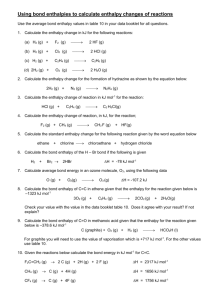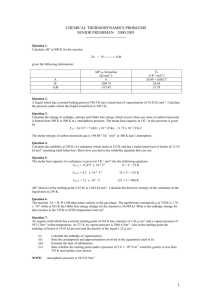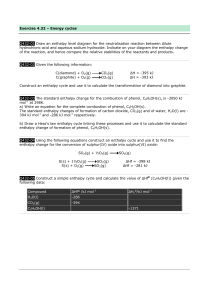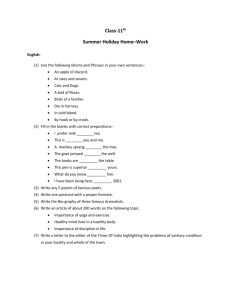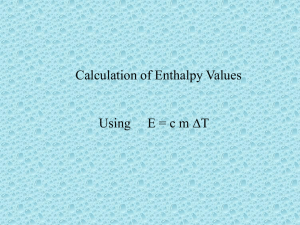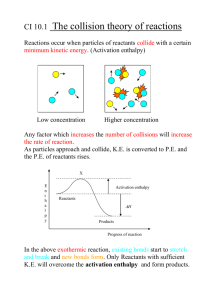1. Energetics - The Student Room
advertisement
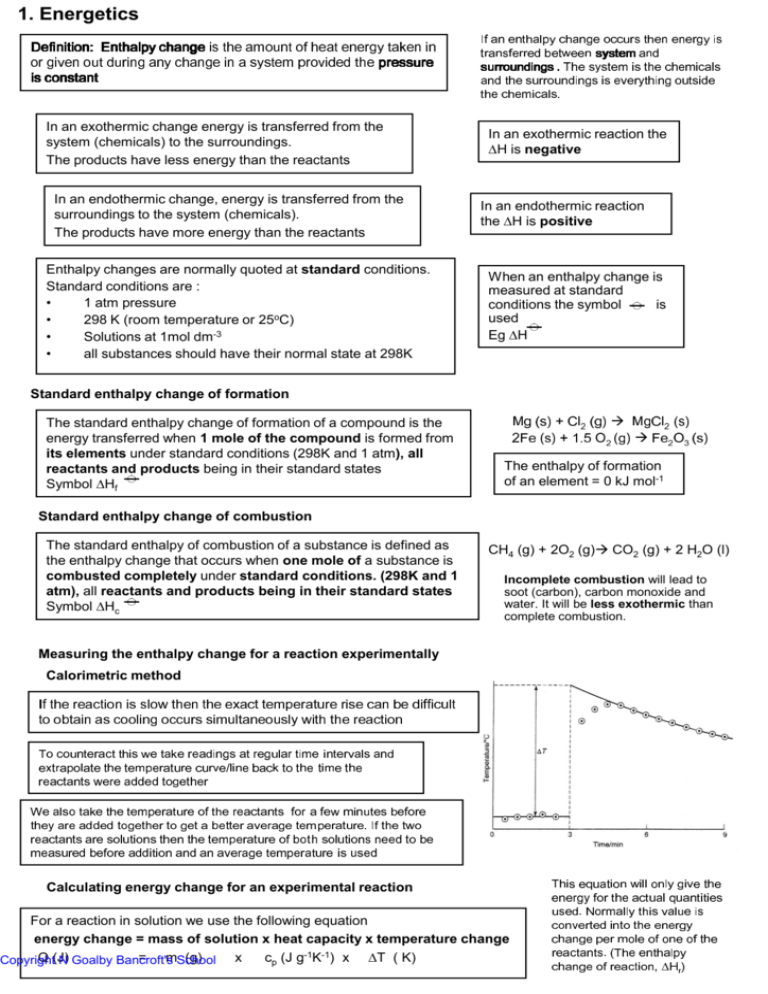
1. Energetics Definition: Enthalpy change If an enthalpy change occurs then energy is is the amount of heat energy taken in or given out during any change in a system provided the is constant pressure system and surroundings . The system is the chemicals transferred between and the surroundings is everything outside the chemicals. In an exothermic change energy is transferred from the system (chemicals) to the surroundings. The products have less energy than the reactants In an endothermic change, energy is transferred from the surroundings to the system (chemicals). The products have more energy than the reactants Enthalpy changes are normally quoted at standard conditions. Standard conditions are : • 1 atm pressure • 298 K (room temperature or 25oC) • Solutions at 1mol dm-3 • all substances should have their normal state at 298K In an exothermic reaction the ∆H is negative In an endothermic reaction the ∆H is positive When an enthalpy change is measured at standard conditions the symbol is used Eg ∆H Standard enthalpy change of formation The standard enthalpy change of formation of a compound is the energy transferred when 1 mole of the compound is formed from its elements under standard conditions (298K and 1 atm), all reactants and products being in their standard states Symbol ∆Hf Mg (s) + Cl 2 (g) 2Fe (s) + 1.5 O 2 (g) MgCl 2 (s) Fe2O3 (s) The enthalpy of formation of an element = 0 kJ mol-1 Standard enthalpy change of combustion The standard enthalpy of combustion of a substance is defined as the enthalpy change that occurs when one mole of a substance is combusted completely under standard conditions. (298K and 1 atm), all reactants and products being in their standard states Symbol ∆Hc CH4 (g) + 2O2 (g) CO2 (g) + 2 H2O (l) Incomplete combustion will lead to soot (carbon), carbon monoxide and water. It will be less exothermic than complete combustion. Measuring the enthalpy change for a reaction experimentally Calorimetric method If the reaction is slow then the exact temperature rise can be difficult to obtain as cooling occurs simultaneously with the reaction To counteract this we take readings at regular time intervals and extrapolate the temperature curve/line back to the time the reactants were added together We also take the temperature of the reactants for a few minutes before they are added together to get a better average tem perature. If the two reactants are solutions then the temperature of bot h solutions need to be measured before addition and an average temperature is used Calculating energy change for an experimental reaction For a reaction in solution we use the following equation energy change = mass of solution x heat capacity x temperature change Q (J) = mSchool (g) x cp (J g-1K-1) x ∆T ( K) Copyright N Goalby Bancroft's This equation will only give the energy for the actual quantities used. Normally this value is converted into the energy change per mole of one of the reactants. (The enthalpy change of reaction, ∆Hr) Calculating the enthalpy change of reaction, ∆Hr from experimental data The heat capacity of water is 4.18 J g-1K-1. In any reaction where the reactants are dissolved in water we assume that the heat capacity is the same as pure water. General method 1. Using q= m x cp x ∆T calculate energy change for quantities used 2. Work out the moles of the reactants used 3. Divide q by the number of moles of the reactant not in excess to give ∆Hr 4. Add a sign and unit (divide by a thousand to convert Jmol-1 to kJmol-1 Also assume that the solutions have the density of water, which is 1g cm weigh -3 . Eg 25cm 25 g Example 1. Calculate the enthalpy change of reaction for the reaction where 25cm3 of 0.2 M copper sulphate was reacted with 0.01mol (excess of zinc). The temperature increased 7oC . Step 1: Calculate the energy change for the amount of reactants in the test tube. Q = m x cp x ∆T Q = 25 x 4.18 x 7 Q = 731.5 Note the mass is the mass of the copper sulphate solution only J Step 2 : calculate the number of moles of the reactant not in excess. moles of CuSO 4 = conc x vol If you are not told what is in excess then you need to = 0.2 x 25/1000 work out the moles of both reactants and work out = 0.005 mol using the balanced equation what is in excess Step 3 : calculate the energy change per mole which is often called ∆Hr (the enthalpy change of reaction) ∆Hr = Q/ no of moles = 731.5/0.005 = 146300 J mol-1 = 146 kJ mol-1 to 3 sf Finally add in the sign to represent the energy change: if temp increases the reaction is exothermic and is given a minus sign eg Remember in these questions: sign, unit, 3 sig figs. –146 kJ mol -1 Example 2. 25cm3 of 2M HCl was neutralised by 25cm3 of 2M NaOH. The Temperature increased 13.5oC What was the energy change per mole of HCl? Step 1: Calculate the energy change for the amount of reactants in the test tube. Q = m x cp x ∆T Q = 50 x 4.18 x13.5 Q = 2821.5 Note the mass is the mass of acid + the mass of alkali J Step 2 : calculate the number of moles of the HCl. moles of HCl = conc x vol = 2 x 25/1000 = 0. 05 mol Step 3 : calculate the energy change per mole which is often called ∆Hr (the enthalpy change of reaction) ∆Hr = Q/ no of moles = 2821.5/0.05 = 564300 J mol-1 = -56.4 kJ mol-1 to 3 sf Copyright N Goalby Bancroft's School Exothermic and so is given a minus sign Remember in these questions: sign, unit, 3 sig figs. 3 will Hess’s Law Hess’s law states that total enthalpy change for a reaction is independent of the route by which the chemical change takes place Hess’s law is a version of the first law of thermodynamics, which is that energy is always conserved. Using Hess’s law to determine enthalpy changes of reaction from enthalpy changes of formation. ∆H reaction = ∆Hf products - ∆Hf reactants Example 3 What is the enthalpy change for this reaction ? Al2O3 + 3 Mg 3 MgO + 2 Al ∆Hr = ∆Hf products - ∆Hf reactants ∆Hr = 3 x ∆Hf (MgO) - ∆Hf (Al2O3) ∆Hr = (3 x –601.7) - -1675.7 = -129.4 kJ mol Remember elements have ∆Hf= 0 ∆Hf (MgO)= -601.7 kJ mol -1 ∆Hf (Al2O3) = -1675.7 kJ mol-1 -1 Example 4. Using the following data to calculate the heat of combustion of propene ∆Hf C3H6(g) = +20 kJ mol-1 ∆Hf CO2(g)= –394 kJ mol-1 ∆Hf H2O(g)= –242 kJ mol-1 C3H6 + 4.5 O2 3CO2 + 3H2O ∆Hc= ∆Hf products - ∆Hf reactants ∆Hc = [3 x ∆Hf (CO2) + 3 x ∆Hf (H2O)] - ∆Hf (C3H6) ∆Hc = [(3 x –394) + (3 x –242)] – 20 = -1928 kJ mol -1 Using Hess’s law to determine enthalpy changes of reaction from enthalpy changes of combustion. ∆H reaction = ∆Hc reactants - ∆Hc products Example 5. Using the following combustion data to calculate the heat of reaction CO (g) + 2H2 (g) CH3OH (g) ∆Hc C0(g) = -283 kJ mol-1 ∆Hc H2 (g)= –286 kJ mol-1 ∆Hf CH3OH(g)= –671 kJ mol-1 ∆H reaction = ∆Hc reactants - ∆Hc products ∆Hr = ∆HC(CO) + 2 x ∆HC(H2 ∆Hr = -283+ 2x –286 - -671 = -184 kJ mol -1 Copyright N Goalby Bancroft's School ) - ∆HC(CH3OH) Example 6. Using the following combustion data to calculate the heat of formation of propene 3C (s) + 3H2 (g) C3H6 (g) ∆Hc H2 (g)= –286 kJ mol-1 ∆Hf C3H6(g)= –-2058 kJ mol-1 ∆Hc C (s) = -393kJ mol-1 ∆H = ∆Hc reactants - ∆Hc products ∆Hf = 3 x ∆HC(C) + 3 x ∆HC(H2 ) - ∆HC(C3H6) ∆Hf = 3x -393+ 3x –286 - -2058 = +21 kJ mol -1 Mean Bond energies The Mean bond energy is the enthalpy needed to break the bond into gaseous atoms, averaged over different molecules We use values of mean bond energies because in reality every single bond in a compound has a slightly different value. E.g. In CH4 there are 4 C-H bonds. Breaking each one will require a different amount of energy. However, we use an average value for the C-H bond for all hydrocarbons. These values are positive because energy is required to break a bond. The definition only applies when the substances start and end in the gaseous state. In general (if all substances are gases) ∆Hr = Σ bond energies broken - Σ bond energies made ∆H values calculated using this method will be less accuate than using formation or combustion data because the mean bond energies are not exact Example 7. Using the following mean bond enthalpy data to calculate the heat of combustion of propene Bond Mean enthalpy (kJ mol-1) ∆H = Σ bond energies broken - Σ bond energies made = [E(C=C) + E(C-C) + 6 x E(C-H) + 4.5 x E(O=O)] 612 C-C 348 O=O 496 O=C 743 O-H 463 C-H 412 – [ 6 xE(C=O) + 6 E(O-H)] = [ 612 + 348 + (6 x 412) + (4.5 x 496) ] – [ (6 x 743) + (6 X 463)] = - 1752 C=C kJmol-1 Example 8. Using the following mean bond enthalpy data to calculate the heat of formation of NH3 ½ N2 + 1.5 H2 NH3 (note the balancing is to agree with the definition of heat of formation (i.e. one mole of product) E(N≡N) = 944 kJ mol-1 E(H-H) = 436 kJ mol-1 E(N-H) = 388 kJ mol-1 ∆H = Σ bond energies broken - Σ bond energies made = [0.5 x E(N≡N) + 1.5 x E(H-H)] – [ 3 xE(N-H)] = [ (0.5 x 944) + (1.5 x 436) ] – [ 3 x 388)] = - 38 kJmol-1 Copyright N Goalby Bancroft's School More complicated examples that may occur at AS Working out ∆Hf of a compound using bond energies and other data elements This is a more complicated example of the type in example 8 Compound in standard state ∆H to turn to elements into gaseous atoms Gaseous atoms The ∆H’s can be combinations of different data ∆H to turn to compound into gaseous atoms Can be bond energies Σ bond energies of compound + (∆H to turn to gas if compound is not gaseous) E(Cl-Cl) Cl2 2Cl Or atomisation energies (if the substance is not diatomic C(s) C(g) Example 9 Calculate ΔH C(s) C(g) f 3 8 ∆H = 715 kJ mol-1 3C (s) + 4H ∆Hf = Bond C–C C–H H–H kJ mol-1 348 412 436 for propane, C H (g), given the following data. 2 (g) C H (g), 3 8 ∆H to turn to elements into gaseous atoms - ∆H to turn to compound into gaseous atoms ∆ Hf = (3x∆ ∆Hat [C] + 4 x E[H-H] ) – (2 x E[C-C]+ 8 x E[C-H] ) = (3x715 + 4 x 436 ) – (2 x 348+ 8 x 412 ) =-103 kJ mol-1 Copyright N Goalby Bancroft's School


